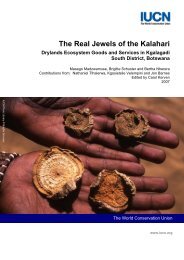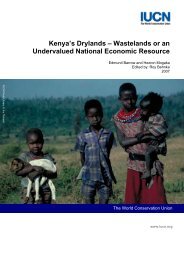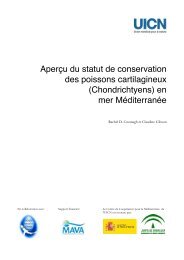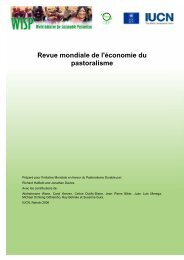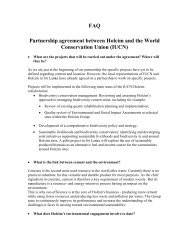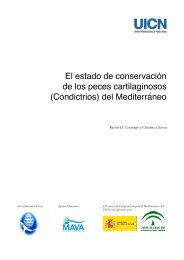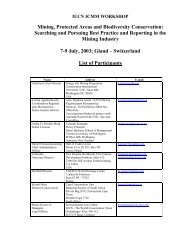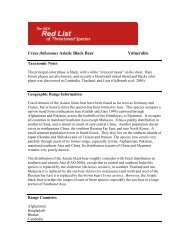iucn mediterranean sharks (pdf) - The Shark Trust
iucn mediterranean sharks (pdf) - The Shark Trust
iucn mediterranean sharks (pdf) - The Shark Trust
You also want an ePaper? Increase the reach of your titles
YUMPU automatically turns print PDFs into web optimized ePapers that Google loves.
8th Conference of Parties in 2005 agreed to begin thedevelopment of a CMS Instrument for the conservation ofall migratory shark species listed on CMS. Progress towardsthis goal will be initiated in 2007. See: http://www.cms.int/ for more information.5.1.2 <strong>The</strong> Convention on International Trade inEndangered Species of Wild Fauna andFlora (CITES)CITES was established in recognition that internationalcooperation is essential for the protection of certainspecies from over-exploitation through international trade.It creates the international legal framework for theprevention of trade in endangered species of wild faunaand flora and for the effective regulation of internationaltrade in other species which may become threatened inthe absence of such regulation. Two Mediterranean <strong>sharks</strong>pecies are listed on Appendix II of CITES: basking sharkand white shark. Proposals to list two more Mediterraneanspecies on Appendix II (porbeagle Lamna nasus and spinydogfish Squalus acanthias) and all species of sawfishPristidae on Appendix I may be debated by the 14thConference of Parties in 2007.CITES’ other major role in promoting the sustainablemanagement of wild species (arguably as important, if notmore important than species listings on its Appendices),is through the adoption of Resolutions and Decisions.Resolution Conf. 12.6 encourages Parties, inter alia, toidentify endangered shark species that requireconsideration for inclusion in the Appendices, if theirmanagement and conservation status does not improve.Decision 13.42 encourages Parties to improve their datacollection and reporting of catches, landings and trade in<strong>sharks</strong> (at species level where possible), to build capacityto manage their shark fisheries, and to take action onseveral species-specific recommendations from theAnimals Committee. Many of the latter taxa are threatenedin the Mediterranean, including spiny dogfish, porbeagle,white shark, tope shark Galeorhinus galeus, sawfishesfamily Pristidae, gulper <strong>sharks</strong> genus Centrophorus,requiem <strong>sharks</strong> genus Carcharhinus, guitarfishes OrderRhinobatiformes, and devil rays family Mobulidae. Angel<strong>sharks</strong> family Squatinidae, sandtiger <strong>sharks</strong> familyOdontaspidae, and thresher <strong>sharks</strong> family Alopidae, werealso identified as of potential concern.Parties were also urged, through FAO and regional fisheriesorganizations, to develop, adopt and implement newinternational instruments and regional agreements for theconservation and management of <strong>sharks</strong>, and to considerrecommendations for activities and guidelines to reducemortality of endangered species of <strong>sharks</strong> in bycatch andtarget fisheries (CITES 2006; Fowler and Cavanagh 2005a).See http://www.cites.org/ for more information.5.1.3 United Nations Convention on the Law ofthe Sea (UNCLOS)UNCLOS provides a framework for the conservation andmanagement of fisheries and other uses of the sea bygiving Coastal States the right and responsibility for themanagement and use of fishery resources within theirnational jurisdiction (the territorial sea, which can extendup to 12 nautical miles). UNCLOS also recognises CoastalStates’ right to claim an exclusive economic zone (EEZ)of up to 200 nautical miles. <strong>The</strong> management goal adoptedby UNCLOS (Article 61(3)) is that of maximum sustainableyield, qualified by environmental and economic factors.<strong>The</strong> provisions of UNCLOS directly related to theconservation and management of <strong>sharks</strong> include the dutyplaced on Coastal States to ensure that stocks occurringwithin their jurisdictional waters are not endangered byoverexploitation. See http://www.un.org/Depts/los/index.htm for more information.Within the Mediterranean, the majority of States haveestablished their 12-mile territorial waters (except Greeceand Turkey). A few countries are in the process of claimingan EEZ. However, because of the difficulties associatedin the delimitation of what is a relatively narrow sea andsince most States want to maintain their basin-wide accessto fisheries, few have claimed an EEZ (Chevalier 2005).As a consequence, there is a large area of high seas in theMediterranean, which requires cooperation betweenCoastal States to ensure the sustainable use of fisheriesresources and conservation of marine biodiversity(Chevalier 2005).5.1.4 United Nations Agreement on theConservation and Management ofStraddling Fish Stocks and Highly MigratoryFish Stocks (UNFSA)UNFSA was established to implement the provisions ofUNCLOS pertaining to the conservation andmanagement of straddling and highly migratory fishstocks. UNSFA (adopted in 1995, ratified in 2001) callsfor Parties to protect marine biodiversity, minimisepollution, monitor fishing levels and stocks, provideaccurate reporting of and minimise bycatch anddiscards, and gather reliable, comprehensive scientificdata as the basis for management decisions. In theabsence of scientific certainty, it mandates a precautionaryapproach to the management of straddling and highlymigratory stocks and species. Cooperation for suchspecies is achieved though regional fisheriesarrangements or organisations. According to Annex Iof UNCLOS, Coastal States and other States who fish inareas where highly migratory species occur are requiredto ensure the conservation and promote optimumutilisation of listed species.21



